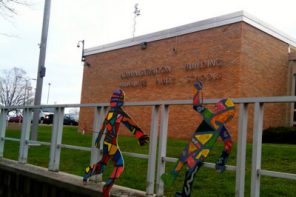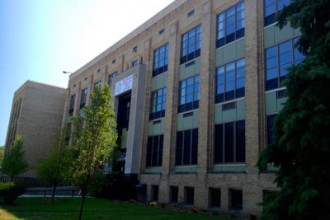On Monday, I posted here about an NAACP report that touted the quality education on offer at Milwaukee Public Schools’ Montessori programs. In it, I wrote that the Montessori High School, an IB World School, housed at the former Juneau High, 6415 W. Mount Vernon Ave., on the West Side, “has struggled.”
That brief comment was based on ongoing chatter in the MPS and public Montessori communities about state test (WKCE) scores (the school’s progress was deemed “Not Satisfactory” in 2009 when it failed to make Adequate Yearly Progress in math), a potential School Improvement Grants Turnaround and word that a principal would be hired to replace the teacher-leaders. (A principal was not hired and the school remains teacher-led.)
Yesterday, I was contacted by Josh Zimmers, who co-founded the school, and by lead teacher Chip Johnston, who took me to task over my comment, noting the school’s many achievements.
For some background, the school is a year-round MPS charter with an enrollment around 300. Just over 70 percent of students are eligible for free and reduced lunch. African American students make up 80 percent of enrollment, white students 12.6 percent, Asian Americans 4.4 percent, 2.4 percent are Latino and just under 1 percent are Native American. Nearly one in four students has a disability.
I applaud Zimmers – who is currently lead teacher/advisor at Kornerstone School, a public charter in the Kimberly Are School District – and Johnston for making their case. I’m happy to say I’ve found no shortage of people like them – folks who are working hard and are passionate about their programs and their students and are quick to defend them – in Milwaukee schools.
And I’m eager to highlight here the school’s successes because I think a vibrant Montessori High School benefits everyone. And because fair is fair.
“Our school is cited as having ‘struggled,’ which it often has, even though that statement is not accurate,” Johnston told me in an email. “Our school has often been labeled as ‘low performing’ or ‘struggling’ because of low math and science WKCE scores over the past few years.
“What is almost never mentioned is that besides those few years of WKCE scores Montessori High School has performed better than district averages in many other performance indicators. Since the school’s creation it has on average had a higher graduation rate, lower grade retention rate, lower student mobility rate, higher reading WKCE scores, higher social studies WKCE scores and, in most years, equal to or greater language arts WKCE scores than MPS averages for schools that serve the same grade levels.”
Johnston noted, too, that Montessori High kids at every grade level scored above the district averages on this year’s MAP (Measures of Academic Progress) tests.
“Unfortunately,” Johnston said, “we are often labeled ‘struggling’ or ‘low-performing’ because current federal and state legislation puts such a high value on the WKCE, which is an exam given only to 10th grade students on a yearly basis. (State Superintendent of Public Instruction) Tony Evers has recently stated to the press that he no longer believes the WKCE is an accurate measurement tool and is working to change the measurement tool the state uses to assess its schools.”
When Zimmers lists some of the other achievements of the Montessori High School, it’s easy to see Johnston’s point – a point most teachers and administrators already know well – that there’s a lot more going on at a school than is reflected in a standardized state test.
Zimmers forwarded me graduation rates for the school the district and the state – culled from the DPI website – and the numbers are pretty impressive. The Montessori High’s overall four-year 85.7 percent rate is exactly the state number, too, and 21 points above the district.
Especially impressive are the numbers for economically disadvantaged students and those with disabilities. The school’s 88.1 percent four-year graduation rate among the former is 16.3 percent higher than the state rate and a whopping 28.1 percent above the district graduation rate for economically disadvantaged kids.
MPS has a 43.3 percent four-year graduation rate among students with disabilities. Across the state that number is 64.6 percent. But at the high school, it’s 73.7 percent.
In addition, Zimmers told me that the high school, in his words:
- Won the Charter School of the Year Award in 2008.
- Won Business Journal’s Green Program of the Year in 2010 for its collaborative project with Discovery World.
- Almost every single graduate in the past 5 years has gone on to college, university or technical program. (Note: According to Great Schools, in 2008, 76 percent of students went on to four-year colleges and universities and 24 percent went to technical and art programs.)
- The school has improved its WKCE scores in each of the past three years, and every other performance indicator – graduation, attendance, drop-out rate, mobility, MAP testing – is far better than the district average.
- The school was awarded a DPI Dissemination Grant to help other schools develop because MHS has been so innovative and successful with students that have traditionally struggled in school.
- The school has a large waiting list of students trying to get a seat because parents that visit the school see that it is a safe, supportive and academically rigorous.

 i evaluate to yes even if there's no image
i evaluate to yes even if there's no image  i evaluate to yes even if there's no image
i evaluate to yes even if there's no image  i evaluate to yes even if there's no image
i evaluate to yes even if there's no image  i evaluate to yes even if there's no image
i evaluate to yes even if there's no image  i evaluate to yes even if there's no image
i evaluate to yes even if there's no image  i evaluate to yes even if there's no image
i evaluate to yes even if there's no image 